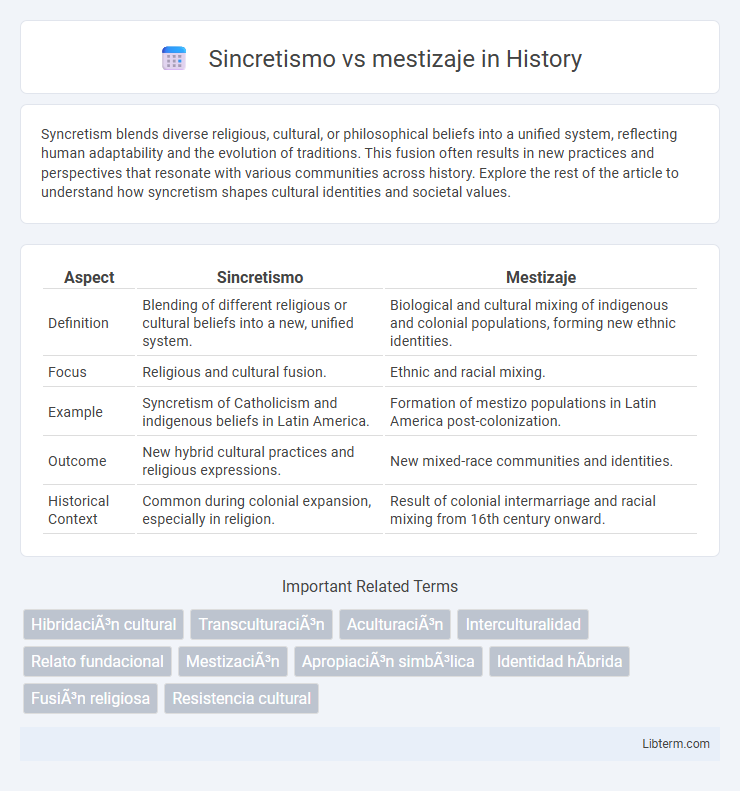Syncretism blends diverse religious, cultural, or philosophical beliefs into a unified system, reflecting human adaptability and the evolution of traditions. This fusion often results in new practices and perspectives that resonate with various communities across history. Explore the rest of the article to understand how syncretism shapes cultural identities and societal values.
Table of Comparison
| Aspect | Sincretismo | Mestizaje |
|---|---|---|
| Definition | Blending of different religious or cultural beliefs into a new, unified system. | Biological and cultural mixing of indigenous and colonial populations, forming new ethnic identities. |
| Focus | Religious and cultural fusion. | Ethnic and racial mixing. |
| Example | Syncretism of Catholicism and indigenous beliefs in Latin America. | Formation of mestizo populations in Latin America post-colonization. |
| Outcome | New hybrid cultural practices and religious expressions. | New mixed-race communities and identities. |
| Historical Context | Common during colonial expansion, especially in religion. | Result of colonial intermarriage and racial mixing from 16th century onward. |
Definición de sincretismo
Sincretismo refers to the process of blending different religious, cultural, or social elements into a new, cohesive system, often seen in contexts where diverse traditions meet and merge without losing their distinct identities. This phenomenon contrasts with mestizaje, which typically denotes biological and cultural mixing resulting in a new, hybrid identity. Sincretismo emphasizes the coexistence and mutual influence of multiple belief systems, especially evident in Latin American indigenous and colonial religious practices.
Concepto de mestizaje
Mestizaje refers to the biological and cultural blending resulting from the intermixing of Indigenous, European, and African populations, particularly in Latin America. This concept emphasizes the creation of new, hybrid identities and cultures, reflecting the mestizo population's diverse heritage. Mestizaje often contrasts with syncretism, which primarily describes the fusion of different religious or cultural practices rather than genetic ancestry.
Orígenes históricos del sincretismo
The historical origins of syncretism trace back to the encounter between indigenous, African, and European cultures during colonization, where disparate religious and cultural practices merged to form new, hybrid systems. Unlike mestizaje, which primarily refers to biological and cultural mixing, syncretism emphasizes the blending of belief systems and rituals to create shared symbolic frameworks. This process was central in Latin America's colonial history, fostering complex identities and cultural expressions that persist in contemporary societies.
Raíces históricas del mestizaje
Mestizaje emerged historically from the widespread intermixing of Indigenous, European, and African populations during the colonial period in Latin America, shaping distinct cultural and genetic identities. It represents a biological and socio-cultural blending rooted in the forced and voluntary unions of diverse ethnic groups under colonial rule. Sincretismo, in contrast, focuses on the fusion of religious and cultural beliefs, often merging Indigenous traditions with European Christian practices, rather than the biological mixture emphasized in mestizaje.
Diferencias clave entre sincretismo y mestizaje
Sincretismo implica la fusion de elementos culturales, religiosos o ideologicos distintos en una nueva entidad coherente, mientras que el mestizaje se refiere a la mezcla biologica y cultural entre diferentes grupos etnicos, especialmente en contextos historicos de colonizacion. La diferencia clave radica en que el sincretismo enfatiza la integracion simbolica y cultural, como en religiones o practicas sociales, mientras que el mestizaje enfatiza la combinacion genetica y social entre poblaciones. Sincretismo se observa en la creacion de nuevas ceremonias religiosas, mientras que mestizaje se reconoce en la diversidad racial y cultural resultante de la interaccion entre indigenas, europeos y africanos.
Impacto cultural y social del sincretismo
Sincretismo cultural fosters the blending of diverse religious and cultural traditions, creating unique hybrid identities that reshape social norms and community practices. This dynamic fusion mitigates cultural conflicts by promoting inclusivity and mutual respect among different ethnic groups. The resulting social cohesion enhances cultural resilience, allowing societies to adapt and thrive amid globalization's pressures.
Influencia del mestizaje en la identidad
Mestizaje profoundly shapes identity by blending indigenous, European, and African ancestries, creating unique cultural expressions and social norms in Latin America. Unlike sincretism, which merges religious beliefs and practices, mestizaje influences language, traditions, and self-perception at a societal level. This fusion fosters diverse identities that challenge rigid ethnic categories and promote a dynamic, pluralistic sense of belonging.
Ejemplos de sincretismo en América Latina
Syncretism in Latin America is exemplified by the blending of Catholicism with indigenous and African religious practices, such as the Day of the Dead in Mexico, which merges Aztec rituals with Catholic All Saints' Day. Another example is the Afro-Brazilian religion Candomble, combining Yoruba beliefs with Catholic elements. These cultural fusions illustrate religious syncretism distinct from mestizaje, which primarily refers to the racial and ethnic mixing of Indigenous, European, and African populations.
Ejemplos de mestizaje en la sociedad contemporánea
Mestizaje in contemporary society is evident in the cultural blending seen in Latin America, where indigenous, European, and African ancestries merge, producing hybrid identities and traditions. Examples include the fusion of indigenous languages with Spanish, the integration of Afro-Latin rhythms like salsa and cumbia in popular music, and culinary practices combining native and colonial ingredients. These mestizo expressions highlight the dynamic process of cultural mixing distinct from syncretism's religious and symbolic synthesis.
Sincretismo y mestizaje: convergencias y desafíos actuales
Sincretismo y mestizaje representan procesos culturales y sociales que fusionan elementos de diversas tradiciones indigenas, africanas y europeas, generando identidades hibridas en America Latina. Mientras el sincretismo se enfoca en la mezcla simbolica y religiosa, el mestizaje abarca dimensiones etnicas y biologicas, implicando una convergencia profunda y compleja. Los desafios actuales incluyen la reivindicacion de saberes ancestrales, la resistencia frente a la homogenizacion cultural y la promocion de politicas inclusivas que reconozcan la diversidad historica y cultural de estas convergencias.
Sincretismo Infographic

 libterm.com
libterm.com